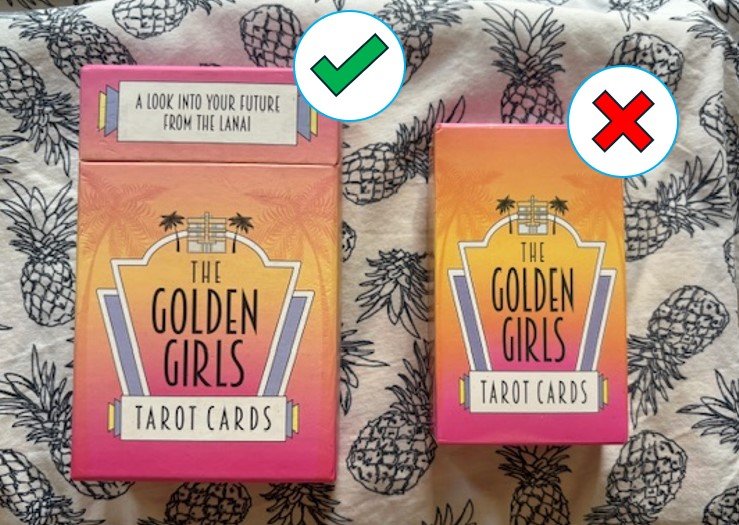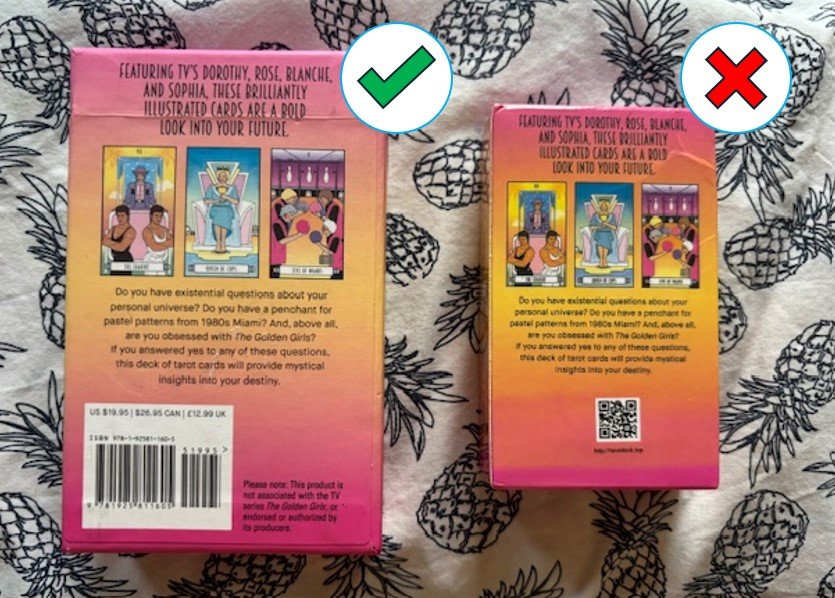The Rise of Tarot Pirates
The Tarot deck industry is worth $1.25 billion dollars a year and is growing at 4% a year. A large part of that is independent deck creators - artists, tarot readers and creators who have within them the passion and skills to make a deck. These “indi decks” can be based on a fandom, an artistic theme, a need for representation, an artist’s personal style or essentially anything.
Speaking as a collector with over 100 decks, I love the diversity of decks. I love all my decks from Salvador Dali to Buffy the Vampire Slayer, from Finnish folk stories to feminist icons, from art deco to Gummybears! But one thing that is becoming an increasing issue is the rise of counterfeit decks as pirate publishers look to make a money off of the backs of the work and creativity of others.
In my early days I was duped into buying several counterfeit decks. But now you don’t have to.
(I’ve included images of a counterfeit Golden Girls Tarot deck alongside the genuine article for reference.)
A genuine Golden Girls Tarot Deck… and a smaller, less appealing knock-off.
The genuine card is bigger, printed on heavier card stock and has more vibrant colours than the counterfeit.
Why does it matter if my deck is a counterfeit?
Artists pour months, sometimes years into the creation of their decks. They put their heart and souls into them and deserve to be rightly praised and rewarded for this - including financially. However, when unscrupulous publishers get their hands on a deck design, they reproduce them at scale - often dwarfing the artist’s legitimate sales and dominating routes to finding the decks such as search engine or Amazon listings. The artist doesn’t see a penny from this - and the customer is left with a cheap but significantly lower-quality product.
This is unfair to everybody. I know piracy is seen as a light crime and often mocked, (we all remember the “You wouldn’t steal a handbag!” ads and years of subsequent memes) but these artists operate on small margins and counterfeit decks rob them on what is rightfully theirs. Added to this many artists are often deliberately working towards admirable goals within their art such as diversifying gender roles, providing a vehicle for minority representation or fostering new ways for people to connect with tarot.
And think about your tarot reading practice. Does authenticity matter to you? Integrity? No matter which deck you use from a classic Colman Smith tarot to an indi deck from an Etsy creator, there is a link between the tarot reader and the artist, and the understanding of their chosen imagery and a reader’s connection to it. In my opinion, by the deck being counterfeited against the artist’s wishes, the deck and the reading are tainted.
How can I tell if my deck is counterfeit?
Firstly - where did you buy it from? If it’s from an Amazon vendor with a long, ambiguous name who sells lots of various cheap things via dropshipping - chances are it’s a counterfeit. Also how much did it cost? If the price seems too good to be true, that’s usually because it’s a pirated copy.
Physically the decks are usually smaller - essentially the cards and packaging with resemble a deck of playing cards. The cards will be thinner and lower quality, the packaging simple and often very susceptible to damage, and the colour may seem faded or less vibrant than you’d expect.
Turn your deck over. Is there a QR code linking to the PDF of the deck’s booklet? That is the biggest giveaway that you have a counterfeit deck. Rather than pirate the accompanying materials physically, the pirate publisher posts multiple decks’ booklets in a shared online PDF.
The giveaway - a QR code on the back of the counterfeit deck.
If you’re unsure if a deck is genuine even after the above tell-tale signs, check the reviews - people will often leave negative reviews and complain about pirate decks. Do your research and contacts artists to check if the deck is legit. If it’s not; be an ally and report the product on the platform (Amazon, Etsy, eBay etc) or speak to the physical store owner. Even real-world witchy stores are falling foul of buying in counterfeit stock from wholesalers who don’t know the difference and are looking for low prices to pass on to their customers.
So… what do I do?
If you do buy a counterfeit deck by accident - don’t feel guilty. You’ve been duped as much as the artist. It happens to all of us. But be cautious and sensible when you’re buying decks. If you do end up with a counterfeit tarot deck; report the item to the store. And if you liked the deck - find yourself a genuine copy; often the artist can be a helpful source of information if they’re contactable, and most are findable after some quick googling..
In terms of how to dispose of the deck… I’m sure some people would look to something more cleansing or ceremonial, but I give mine to charity. If a charity can make a few pounds from the fake deck then at least some good has come of it.
Be careful out there. Love the decks you use and use the decks you love. And support independent artists!


